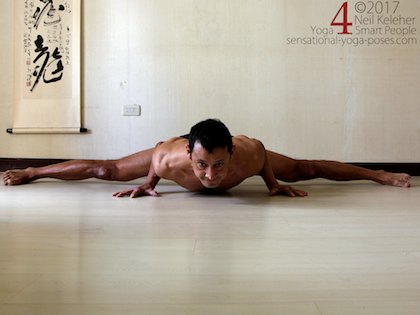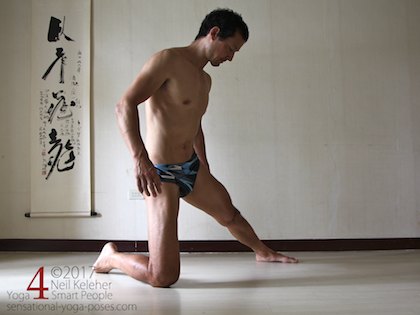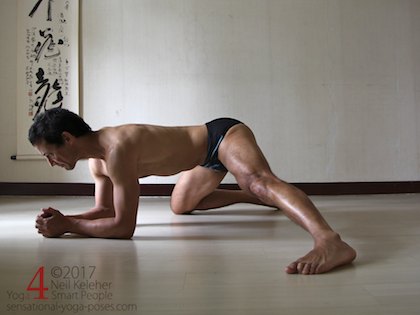Smoothing the Road
You could think of a joint capsule as similiar to a car tire. A tire, when properly inflated, prevents the rim of the wheel from bashing into the road any time the wheel experiences a bump or hole in the road. In the same way joint capsules prevent the bones that they connect from touching each other during sudden and/or repeated impacts and shocks (such as those experienced while running around) or while under heavy loads (such as experienced in middle splits).
Where tires have to be filled with air in order to prevent impact, synovial joint capsules contain fluid, which is incompressible. The fluid inside of a joint capsule has to be pressurized via the joint capsule to prevent bones from impacting each other. Because joints are designed to allow changes in relationship, tension throughout the joint capsule has to be adjustable in any configuration.This tension is controlled and adjusted by muscle tension.
You can read more about a model for synovial joints in Fluid Tensegrity and Joint Anatomy but the short version is that joint capsules are designed to maintain space between bones and changes in muscle tension is what helps to keep bones from touching no matter how the bones are positioned relative to each other.
Pressurizing Synovial Fluid
Try squashing a water balloon between your hands. The more you squeeze the more it bulges out at either end. While joint capsules contain only a very little fluid, muscle actions can tighten the joint capsule in such a way that it pushes outwards against the bones it connects (or resists them pushing towards each other) preventing them from coming into contact.
Because muscle activity is used to help control joint envelope tension (and thus fluid pressure inside the joint) the failure or inability of a muscle to activate can affect the ability of a joint capsule to keep bones from touching.
Based on this understanding, we could say that joint integrity depends on fully functional muscles so that it can prevent the bones from touching (or pulling too far apart), no matter what forces or changes in forces it experiences.
Since joints have no redundancy, no "overlap" of function, it would make sense that the brain be programmed to operate muscles in a way to prevent any movements or actions that endanger joints. It can engage muscles in such a way as to prevent stretching or movement past a certain point. For example, stretching towards middle splits, if may turn on the adductors to prevent stretching beyond a particular point not to protect muscles (or not just to protect muscles) but to protect joints.
Failing that, it may send pain signals to hinder movement, a message from your brain telling you that if you keep on doing what you are doing you are going to damage a joint.
Why Your Knees Might Be Limiting Your Middle Splits
Working towards the middle splits while your legs are bearing weight, if the muscles that work on the knee aren't being turned on in a way to help maintain knee joint integrity, and the brain senses this, then it will limit your ability to go deeper by turning muscles on in a way to stop the stretch or by sending a pain signal.
It may also limit your middle splits if it perceives that, moving beyond a certain point, your hip joints or SI joint integrity will be compromised.
The brain is putting on the brakes in order to keep your joints from being damaged.
Using Understanding and Muscle Control
To Work Towards Middle Splits
Understanding how joint integrity is maintained can give you some ideas for how to create and maintain knee integrity or for that matter, Hip Joint or SI Joint integrity while doing the middle splits (and other postures or stretches). Since joint integrity depends on muscle activation, muscle control is how you can work at maintaining (or creating) joint integrity so that you can go deeper in the splits.
Muscle control includes being able to turn muscles on and off. It also includes sensing changes in muscle activation and tension. Muscle control is just as much about listening to your body as it is choosing what to do with it.
Turning Sensation Into Information
Basic sensations you can tune in to are: muscle activation and relaxation.
Muscle activation sensation is the sensation that is created within the belly of the muscle. If you flex a bicep, muscle activation is the sensation created in the biceps muscles while you are flexing them. Muscle relaxation is the sensation, or it's lack that occurs when a muscle is relaxed. It is an absence of muscle activation sensation.
Where muscles are two thin or two small to feel directly, their activation can be inferred by sensations created in the connective tissue of opposing muscle. As an example (not strictly relevant to middle splits unless your arms are in a push-up like position) the serratus anterior is hard to feel directly. But you can infer it's activation by the sensation (or stretch) that it creates in the connective tissue of the muscles that connect the shoulder blades to the spine (the rhomboids and possibly the lower trapezius).
Another place to look for sensory information is at the insertion points of muscles. These bony landmarks are frequently quite easy to identify.
Mapping Your Body
So that you have a map of sorts to guide your exploration of middle splits, it helps to understand, as a starting point, the muscles that affect the knee joint and how they overlap.
Muscles that affect the knee joint and that you can look at for sensation include:
- The four "heads" of the quadriceps,
- The gastrocnemius (a calf muscle),
- The two heads of the biceps femoris (outer hamstrings),
- The muscles that work on the IT Band (Tensor Fascia Latae and attached portion of Gluteus Maximus, plus the Vastus Lateralis along the outside of the thigh),
- The Sartorius, Gracilis and Semitendinosus (all of which attach to the inside of the knee at the pes anserinus),
- The Adductor Magnus Long Head (to which the vastus medialus obliqus attaches) and the semimembranous.
Turning Tension into Information 2
Sensation from muscle activation will vary according to the amount of stretch a muscle is undergoing. A muscle that is active but not being stretched will provide a stronger more muscular sensation than when that same muscle while it is stretched and active. You may get more of a feeling of stretch from the muscle than of activation.
Other sensations to watch out for are feelings of weakness, like tendons aren't quite strong enough.
Pain is another sensation and there are different types of pain. Sharp pain, particularly at the joints is best avoided.
If you can feel muscles that are extremely tense while working towards the splits (or in any other stretch or poseture), the reason those muscles are excessively active may be to stop you from going deeper but in addition to help protect a joint that is in danger.
Rather than continually trying to "stretch" muscles in this condition it may help to investigate why it is tight in the first place. It might be trying to protect a joint from injury.
Muscle Overlap
Muscles overlap at the joints. This allows us to move smoothly from one posture or position to another and it allows us to locomote. As an example of muscle overlap, the gastrocnemius is one of two large calf muscles. It's bottom end attaches to the heel while its two upper tendons cross the back of the knee to attach at two main points on the femur. Meanwhile, the hamstring muscles also crosses the back of the knee at two places. The tendons of the two sets of muscles actually interloc behind the knee. Because of this overlap, if one of these muscles isn't functioning, the brain may turn on the overlapping muscle to compensate. I had an outer hamstring which was extremely tight. Thinking that it was being used to protect the knee and compensating for something else, I tried activating the calf on that side. The hamstring was then able to relax. (It might have been the other way around, I might have activated the hamstring to get the calf to relax.)
Muscle Logic and Basic Muscle Control Principles
Understanding that changes in muscle tension not only create movement (or resist it), but also help to protect joints can give rise to the idea of muscle logic.
Tension within a joint capsule has to be balanced to prevent any part of the joint capsule envelope from bulging. Given two muscles acting on one side of a joint (1 and 2) and one muscle acting on the other side of the joint (3), if one of the two muscles, say 1, is active, the opposing muscle 3, will activate to counter it. Because the forces these muscles exert are balanced, the other muscle, 2, won't be able to activate. The only way it could activate is for the single muscle on the other side to exert even greater force.
A muscle needs a stable or fixed end point for controllability. Lacking a stable end point, a set of muscles may turn on and exert against each other to create stability. This may inhibit other muscles from turning on or off. As a result of this, one of the first things you can look at creating when practicing muscle control is creating a fixed end point for the muscle(s) that you are trying to control.
Doing the middle splits, you could "stiffen" your feet and ankles. Stiffening your feet and ankles, you give the muscles that cross the knee a stable foundation from which to work on the thigh and hips. Stability then radiates outwards (or upwards) from the foot and ankle.
Because the shins have some ability to rotate relative to the thigh, the muscles that cause this rotation can be used against each other to stabilize shin rotation relative to the pelvis, particularly when the knees are straight or only slightly bent. These muscles include: Tensor Fascia Latae, fibers of Gluteus Maximus that attach to the IT Band, Sartorius, Gracilis and Semitendinosus). When activated against each other, this can give foot, ankle and knee joint muscles a stable foundation via the shin and hip joint muscles a stable foundation via the pelvis.
Learning Muscle Control
I generally practice and teach muscle activation in progressively more difficult poses with the intent that once you learn how to feel and control a particular set of muscles you can use that awareness and control at any time, even in poses that you haven't used it in before.
Half Side Splits Is a pose that I frequently use as a preparation for middle splits. In both versions shown I've engaged the quadriceps of my straight leg as part of my Muscle Control practice.
If I want to use some sort of muscle control in middle splits, then I'll practice (or warm up) with that method using Half Side Splits.
When first learning muscle control the first step is just being able to turn a muscle on and off at will. Once that has been arrived at, the next step is to work at activating and relaxing smoothly and slowly.
So for example, I could practice activating and relaxing my quadriceps in upright side splits, then bent forwards with hands on the floor. Then, after having done both sides, I could try the same muscle activation in middle splits. The idea would be to practice muscle control not at full stretch. Then gradually go deeper. Going deeper, it becomes more important to activate and relax slowly and smoothly. That way I can then stop if I sense a problem.
Why activate the quadriceps in middle splits if it's the adductors that you are trying to stretch? Because the quadriceps can be used to maintain knee joint integrity.
Note, that with the knee straight, activating the quadriceps will also activate the hamstrings. This is because the knee is kept straight while the quadriceps are activated. As a result you should be able to feel increased tension in your hamstrings tendons as the quadriceps are engaged.
Balanced Muscle Control
One of the nice things about practicing muscle control is that once you've learned it you don't have to think about how to do it in order to do it. The challenge is that activating the same muscles every practice doesn't always get the same results. And so when working towards the middles splits, I might practice activating the quadriceps and hamstrings on one day then inner and outer thighs on another day. Also, there are different methods that I use to activate muscles, so I might change methods after a few practices.
Because muscles overlap, there seems to be variations on maintaining joint integrity. Or it might be that training one method, strengthens one set of muscles while ignoring others, and so it helps to switch the muscles you activate (or the methods you use) so that balance is maintained.





